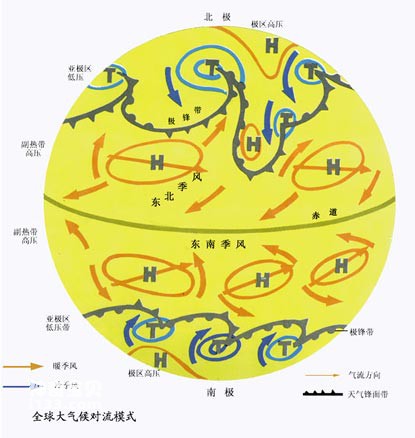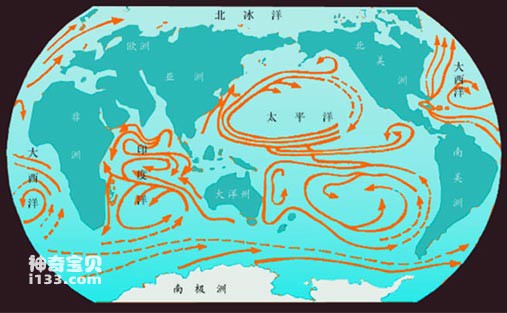As we all know, both humans and animals have blood, and blood vessels are located throughout the body, relying on it to transport nutrients and maintain life and health.
The vast ocean is not a pool of stagnant water, but full of vitality. The water is flowing all the time. Open a ocean current map, and you will find that the earthworm-like curves on it represent the general route of seawater flow. They are connected end to end and circulate endlessly. This is the circulation on the surface of the ocean. We vividly compare it to the "blood of the ocean".
There are various forms of ocean currents flowing in the ocean. In addition to surface circulation, there are also undercurrents that secretly flow in the lower layer, upwelling from below, and downwelling that sinks to the bottom. The water temperature of ocean currents is higher than that of the surrounding sea. Warm currents with warm water temperatures, cold currents with water temperatures lower than those flowing through the sea, vortex currents with rotating water, etc. Ocean currents spread throughout the entire ocean, with both main streams and tributaries, constantly transporting salt, dissolved oxygen and heat, making the ocean full of vitality.

global atmospheric convection model
The water in the ocean is never still. It is like a river on land, flowing along a relatively fixed route for many years. This is the "ocean current". However, there is land on both sides of the river, while there is still sea water on both sides of the ocean current. Under normal circumstances, it is difficult to see with the naked eye. The largest ocean current in the world is hundreds of kilometers wide, thousands of kilometers long, and hundreds of meters deep. Currents in the ocean are very large. Ocean currents don't always flow in one direction. In the North Pacific, there is a clockwise circulation at the surface; in the South Pacific, there is also a circulation in the opposite direction. They are counterclockwise gyres composed of the South Equatorial Current, the East Australian Comb, the Westerly Drift, and the Peruvian Current. There is also a circulation in the southern and northern parts of the Atlantic Ocean, which is roughly similar in appearance to the Pacific Ocean. The North Atlantic circulation consists of the North Equatorial Current, the Gulf Stream, the North Atlantic Current and the Canary Current; the South Atlantic circulation consists of the South Equatorial Current, the Brazilian Current, the westerly drift and the Benguela Current. The Indian Ocean is a bit special. It only has a circulation south of the equator. It is located in the middle of the Indian Ocean and north of the equator. The ocean area is too small and it is affected by the land, so it cannot form a stable circulation all year round. Due to different seasons, the direction of sea currents in the northern Indian Ocean changes with the monsoon. In summer, it flows from east to west, forming two small clockwise circulations in the Bay of Bengal and the Arabian Sea. In winter, it is the opposite, with the sea currents flowing from west to east. Due to its special location and being dominated by the Atlantic currents, the Arctic Ocean only forms a clockwise circulation.

Global ocean circulation model diagram
There are many reasons for the formation of ocean circulation. Wind, the position of the ocean, the distribution of land and sea, and the deflection force generated by the earth's rotation (called the Coriolis force) all exert influence. It can be said that it is the result of a combination of many factors. Wind not only creates waves, but also blows sea water into currents. Stable winds all year round can form a long-lasting ocean current. The long-lasting equatorial current is formed by easterly winds blown by the trade wind belt. The stable westerly drift is attributed to the strong westerly wind belt. Therefore, some people call surface ocean currents "wind currents." However, the "ring" formed by ocean circulation cannot be credited entirely to the wind's account book. The distribution of the continents and the role of geostrophic deflection force both occupy an important position. When the equatorial current travels westward and reaches the western edge of the ocean, it is blocked by the continent. There are only two ways out in front of it, one is to return to the east coast along the original route, and the other is to turn. However, because the "follow-up troops" were so vast and following in a steady stream, it was impossible for them all to return, so they had to separate a small group to sneak into the lower layer and return, becoming the equatorial undercurrent; most of the rest had to turn around and find another way. keep going. Where to turn? At this time, the geostrophic deflection force helped it. In the Northern Hemisphere, ocean currents turn to the right due to the geostrophic deflection force, while in the Southern Hemisphere, they turn to the left. Coupled with the obstruction of the continent, the ocean currents turned poleward on a large scale. As the sea current marches towards the pole, the geostrophic force never relaxes for a moment, and the force of the deflection becomes stronger and stronger. When the latitude reaches about 40 degrees, the strong westerly belt and the geostrophic deflection force form a combined force, causing the sea current to become eastward. Drifting in the west wind. In the same way, when westerly winds drift near the east coast of the ocean, they must take the path to the equator, thus completing a large cycle.
animal tags:
We created this article in conjunction with AI technology, then made sure it was fact-checked and edited by a Animals Top editor.